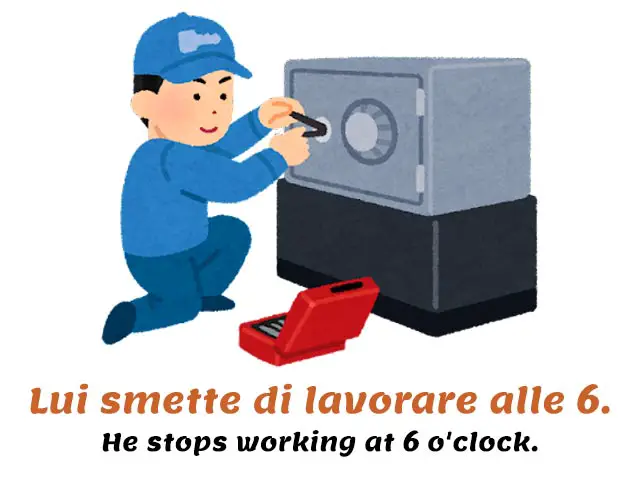How exactly do you say stop it in Italian?
In this lesson, we will take a look at the different ways you can translate this sentence into Italian. Read on to learn them all!
Let’s start! Iniziamo!
How do you say stop it in Italian?
Smettila!
Smettila! is how you translate stop it into Italian in informal contexts and when you are addressing one person.
Smettila!
Stop it! (informal)

This common sentence in Italian is made of two elements.
Smetti-
You stop (imperative)
-la
Direct object pronoun for “it”
Mi stai facendo male, smettila!
You’re hurting me, stop it!
Non è divertente! Smettila!
It’s not funny! Stop it!
Smetti is the second person singular conjugation of smettere, to stop, in the imperative mood.
The imperative mood and present tense conjugations for smettere are as follows.
Imperative mood conjugation for smettere
| io | — |
| tu | smetti |
| lui, lei | smetta |
| noi | smettiamo |
| voi | smettete |
| loro | smettano |
Title: Italian All-in-One For Dummies
Language: English / Italian
Publisher: For Dummies
Pages: 672
Learn to speak Italian like a native? Easy.
Italian All-in-One For Dummies appeals to those readers looking for a comprehensive, all-encompassing guide to mastering the Italian language. It contains content from all For Dummies Italian language instruction titles, including Italian For Dummies, Intermediate Italian For Dummies, Italian Verbs For Dummies, Italian Phrases For Dummies, Italian Grammar For Dummies, and Italian For Dummies Audio Set.
Smetti subito di saltare in quella pozzanghera!
Stop jumping into that puddle right now!
Smettete di fare casino!
Stop making noise! (plural you)

Present tense conjugation for smettere
| io | smetto |
| tu | smetti |
| lui, lei | smette |
| noi | smettiamo |
| voi | smettete |
| loro | smettono |
Il bambino smette di giocare e inizia a fare i compiti.
The child stops playing and starts doing homework.
Gli operai smettono di lavorare alle 6.
Workers stop working at 6 o’clock.

If you’re a bit familiar with Italian direct object pronouns, you will know that the pronoun la is the feminine translation of the English word “it” (lo is the masculine pronoun). This is because Italian has two genders, masculine and feminine, unlike English which only has one.
You translate stop it in Italian as smetterla because the pronoun is merged to the verb itself, dropping its final -e.
So why is the feminine pronoun used here? Why is it not smetterLO? There’s no logical reason, it all comes down to the verb being this way. You can’t say “smetterlo” in Italian as much as you can’t say “to make a shower” in English.
Smettetela!
Smettetela! is how you translate stop it in Italian when you are addressing more than one person, regardless of the degree of formality needed.
Smettetela!
Stop it! (plural)
If you paid close attention to the conjugation tables above, you will have noticed that the imperative conjugation of the verb smettere for the pronoun voi (plural you) is smettete.
You will then need to add the direct object pronoun, -la. This is why we say smettetela.
Smettetela, bambine! Il papà sta dormendo.
Stop it, children! Dad is sleeping.
Ragazzi, smettetela. Non litigate.
Guys, stop it. Don’t fight.

La smetta!
La smetta! is how you say stop it in Italian in formal situations.
La smetta!
Stop it! (formal)
La smetta di importunarmi, per favore!
Please stop bothering me!
For example, if a stranger is bothering you, you would use this sentence because you are not familiar with them. Any person you are not on familiar terms with will need to be addressed with the formal You in Italian.
Now, direct object pronouns in Italian have a special feature: when a formal imperative is present, any direct object pronoun goes before the verb. This is why we say la smetta, and not smettala.
Fermati! Fermatevi! Si fermi!
These three exclamations translate stop! in Italian.
Fermati!
Stop! (singular)
Fermatevi!
Stop! (plural)
Si fermi!
Stop! (formal)
Fermati! Ti ho detto di fermarti!
Stop! I said, stop!
While smettere means to stop, it’s more geared towards actions, eg. to stop doing something. The verb fermare, however, is the direct translation of to stop into Italian: to cease all movement.
All three sentences use the reflexive form of fermare, which is fermarsi, in the imperative mood.
| io | — |
| tu | fermati |
| lui, lei | si fermi |
| noi | fermiamoci |
| voi | fermatevi |
| loro | si fermino |
And that’s it, now you know how to say stop it in Italian in all its forms!
What next?
➡️ Learn other common Italian questions!
Now that you’ve seen how to say stop it in Italian, you might want to keep learning Italian online with these free Italian resources:
❤️ If you liked this lesson on how do you say stop it in Italian, consider sharing it with your social media friends who are also studying Italian.



